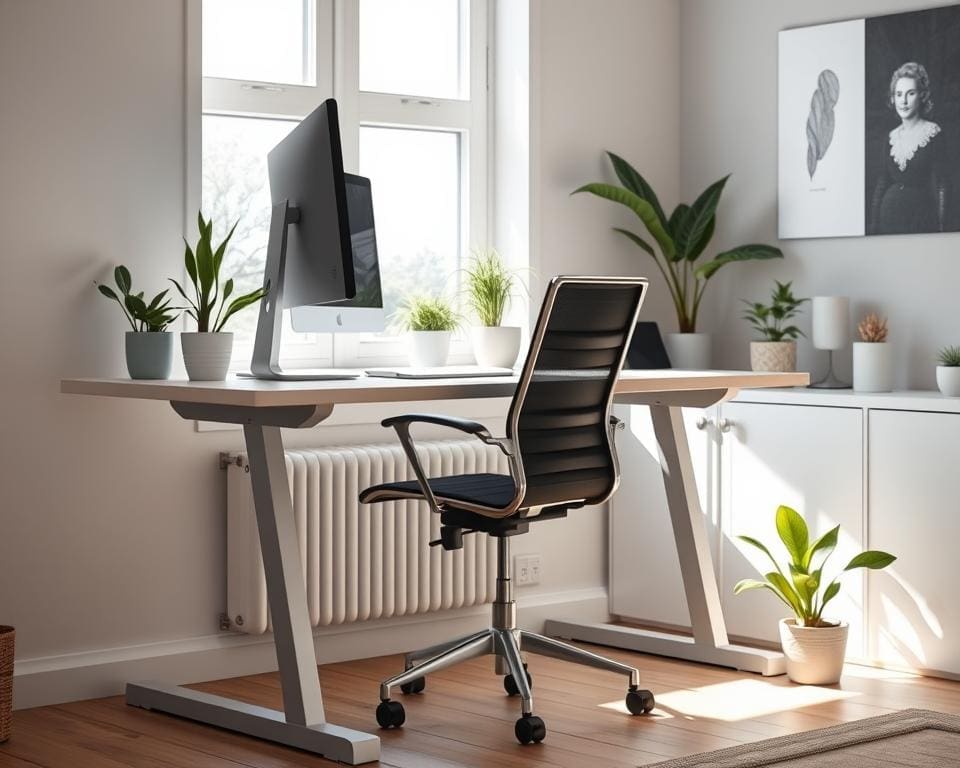In today’s increasingly digital world, the shift towards remote work has highlighted the significance of home office ergonomics. Standing desks have emerged as a vital component of ergonomic furniture, designed to create healthier and more productive work environments. These innovative solutions, particularly adjustable height desks, allow individuals to alternate between sitting and standing, helping to combat the detrimental effects of prolonged sitting. By incorporating standing desks into your home workspace, you can foster a dynamic atmosphere that supports overall well-being and enhances productivity.
Understanding Home Office Ergonomics
Creating a comfortable and efficient workspace is crucial in today’s remote working environment. Home office ergonomics play a significant role in ensuring that one’s workspace is designed to suit individual needs and capabilities, ultimately boosting productivity and well-being. This section delves into the importance of ergonomics and the common issues encountered when working from home.
The Importance of Ergonomics in the Home Office
Proper ergonomics can lead to substantial advantages. By prioritising home office ergonomics, individuals can reduce fatigue and discomfort during long working hours. Better workspace design promotes posture improvement, which helps prevent musculoskeletal disorders. Enhancing one’s workspace supports focus and efficiency, enabling workers to accomplish more throughout the day.
Common Ergonomic Issues Faced While Working from Home
While working from home offers flexibility, it can also lead to several ergonomic issues. Typical problems include:
- Poor posture due to unsuitable chairs and desks.
- Inadequate screen height resulting in neck strain.
- Repetitive strain injuries from improper keyboard placement.
Addressing these issues is vital for fostering a healthier and more productive work environment. Recognising the significance of home office ergonomics ensures that individuals can work comfortably and efficiently in their chosen spaces.

Benefits of Standing Desks
Standing desks offer a wealth of advantages that extend beyond mere comfort. The incorporation of ergonomic furniture into the workspace can significantly impact overall health and well-being.
Health Benefits of Standing Desks
Numerous studies have illustrated the health benefits of standing desks. These desks have been linked to a reduction in the risk of obesity, cardiovascular disease, and even type 2 diabetes. Standing more often can boost energy levels and promote a more active lifestyle, contributing to an enhanced sense of vitality. With these desks, individuals often experience improved circulation and reduced fatigue, making them a valuable addition to any home office.
Posture Improvement with Standing Desks
One of the most noteworthy benefits of standing desks is their role in posture improvement. By encouraging better spinal alignment, these desks help individuals maintain a more natural posture. This adjustment can reduce strain on the back and neck while promoting overall comfort during work hours. Adopting an ergonomic workspace design makes a substantial difference in how individuals feel throughout the day.
Standing Desks for Improved Home Office Ergonomics
Embracing standing desks can transform the productivity at home office environments. Many professionals have reported a significant increase in their efficiency and engagement when they shift from traditional sitting to standing while working. The interaction between posture and productivity reveals that standing promotes alertness and can uplift one’s mood, creating a vibrant workspace that fosters creativity and focus.
How Standing Desks Enhance Productivity at Home Office
Integrating standing desks into a home office can greatly amplify your productivity levels. They encourage a more active approach to work, helping to combat the lethargy that often accompanies continuous sitting. Key benefits include:
- Enhanced energy levels: Standing while working can lead to reduced feelings of fatigue.
- Improved focus: The physical act of standing can enhance mental acuity and concentration throughout the working day.
- Positive mood shifts: Increased blood flow and movement contribute to a better outlook and a more motivated work ethic.
Adjustable Height Desks: The Flexibility Factor
Adjustable height desks provide the ultimate solution for those seeking flexibility in their workspace. The ability to easily transition between sitting and standing allows individuals to tailor their working environment according to their comfort and needs. This adaptability can significantly enhance one’s experience in a home office. Consider the advantages:
- Personal comfort: Users can adjust the desk height to fit their specific ergonomic requirements.
- Varied work positions: Alternating positions throughout the day helps prevent strain and discomfort.
- Encouraged movement: Standing breaks facilitate movement, which can invigorate mental capabilities.
Choosing the Right Standing Desk
Selecting the ideal standing desk can greatly impact your working experience. Prioritising the right elements not only enhances comfort but also promotes productivity. Whether you’re transitioning to a standing setup or upgrading your current ergonomic furniture, understanding what to look for is crucial.
Key Features to Look for in Ergonomic Furniture
When embarking on the journey of choosing a standing desk, consider these essential features:
- Stability: A sturdy desk prevents wobbling, ensuring a comfortable workspace.
- Adjustability: Look for options that allow for height modifications to suit your specific needs.
- Ease of Use: Mechanisms, whether manual or electric, should facilitate quick adjustments.
- Size Compatibility: Ensure the desk fits well within your workspace without crowding.
Comparing Sit-Stand Desks
Exploring the different types of sit-stand desks unveils a wide range of functionality. Many models are equipped with features that facilitate seamless transitions between sitting and standing positions.
Key comparisons include:
- Manual sit-stand desks offer simplicity and often a lower price point, appealing to those who prefer minimal technology.
- Electric sit-stand desks provide a convenient adjustment at the touch of a button, ideal for frequent position changes.
- Hybrid models incorporate both electric and manual options, allowing users to choose based on their preference.
Integrating Standing Desks into Your Workspace
Transforming a home office to include a standing desk can greatly enhance productivity and comfort. Achieving an ergonomic workspace requires strategic planning and thoughtful arrangements. Effective integration involves adjusting desk height, aligning monitors, and positioning peripherals correctly to promote a healthy posture.
Setting Up an Ergonomic Workspace
When creating an ergonomic workspace, the desk height should be tailored to your specific needs. The ideal height allows your elbows to sit at a 90-degree angle while typing. Screens should be positioned at eye level, ensuring that you do not strain your neck. Items such as keyboard and mouse should be easily accessible, minimising the need to reach excessively.
Tips for Transitioning to a Standing Desk
Transitioning to a standing desk can be a smooth journey with a few practical tips. Start by incorporating short standing periods into your day, gradually increasing the time as your body adjusts. Remember to listen to your comfort levels, allowing for frequent movement breaks to avoid fatigue. Emphasising these simple strategies during the transition helps foster a productive and energised workspace.
Addressing Back Pain Relief with Ergonomic Solutions
Back pain has become a common concern for many individuals working from home. Poor posture, extended sitting, and inadequate workspace design can all contribute to discomfort and long-term injury. Implementing ergonomic solutions plays a vital role in promoting back pain relief. Standing desks offer a compelling option for improving posture and encouraging movement throughout the day.
The design of standing desks supports better spinal alignment, which is crucial for reducing strain on the back. Users often report significant improvements in both comfort and energy levels after integrating these desks into their home office setups. To further enhance back pain relief, adding accessories like anti-fatigue mats can provide cushioning, while ergonomic chairs can serve as an excellent complement for those transitioning between sitting and standing.
Real-life experiences highlight the transformative impact of these ergonomic solutions. Many users have noticed a marked reduction in discomfort after making these adjustments. By investing in quality standing desks and carefully considering workspace arrangements, one can create an environment that fosters both productivity and physical well-being.
Ultimately, addressing back pain involves a holistic approach. This includes being mindful of one’s posture, taking regular breaks to move about, and utilising ergonomic solutions that cater to individual needs. Making these changes not only improves back pain relief but enhances the overall productivity of home office spaces.
Conclusion and Future of Home Office Ergonomics
In summarising the importance of standing desks, it’s clear that they play a vital role in promoting healthier home office ergonomics. Throughout this article, we’ve explored how adopting such ergonomic solutions can not only alleviate back pain but also enhance productivity. The incorporation of standing desks is not merely a trend; it represents a significant step towards creating functional and health-oriented workspaces.
As we look ahead, the future of home office ergonomics is brimming with promise, marked by innovative designs and advanced technologies. Ergonomic innovations are continually evolving, ensuring that home office setups cater to individual needs while improving overall well-being. Furthermore, as remote work seems poised to remain a fixture in our lives, investing in proper ergonomic furniture is more essential than ever.
In conclusion, staying informed about advancements in standing desks and related ergonomic solutions will empower individuals to optimise their home offices. It is time to embrace these changes and take actionable steps towards enhancing our work environments, thereby fostering a productive and healthy future.









